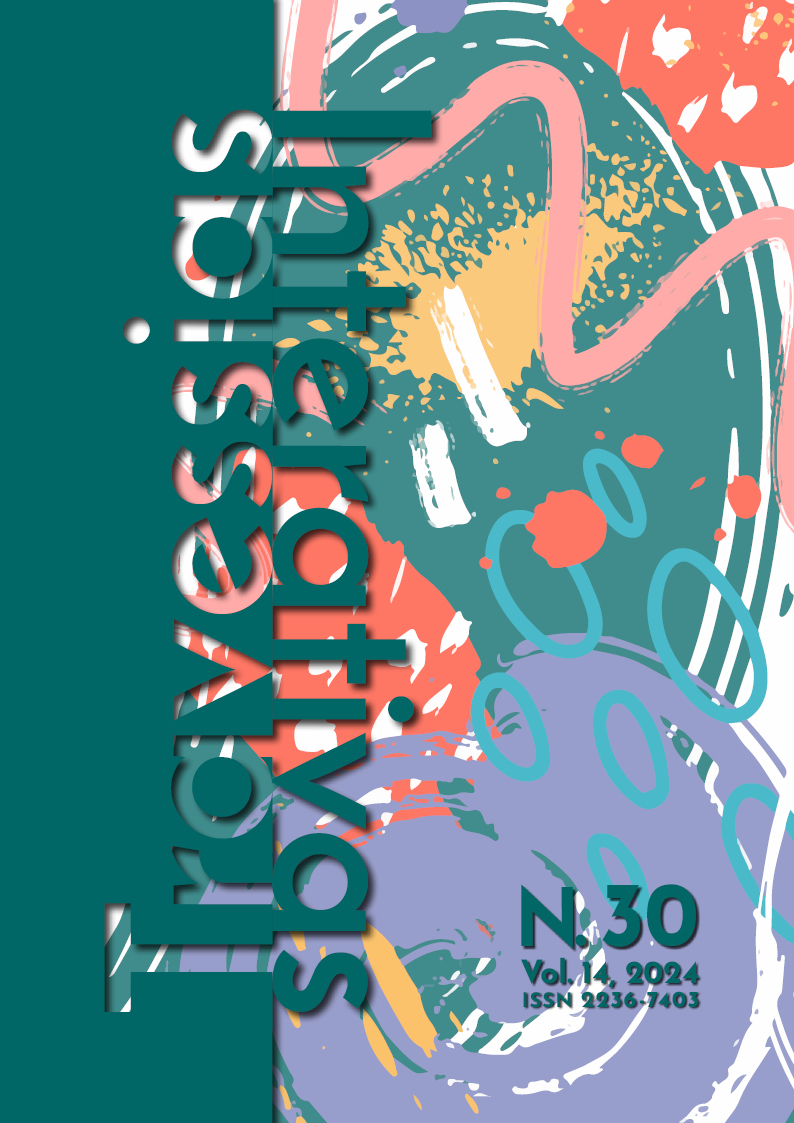Intersemiotic translation of Ophelia’s death in tragedy, painting and cinema
a reflection on the relation between the feminine and death
DOI:
https://doi.org/10.51951/ti.v14i30.p214-225Keywords:
Ophelia. Painting. Tragedy. Cinema. Intersemiotic Translation.Abstract
This work discusses the death scene of Ophelia from the visual representations of her in the tragedy of Hamlet as a proportionate artistic manifestation of singular resignifications in painting and cinema. To do so, it addresses the corpus, namely beyond the tragedy Hamlet, the painting “Ophelia” of the painter John Everett Millais and the film Ophelia (2018) of the director Claire McCarthy as scriptures (BARTHES, 2004) whose senses become mobile because of the relationships it keeps between themselves. Thus, we analyze the intersemiotic translation (PLAZA, 2003) of tragedy for painting and from the painting for cinema, observing how these two forms of intertextuality (KRISTEVA, 1974) preserve the poetic image (NITRINI, 2021) generated by the reader’s aesthetic gaze on the death of Ophelia. Thus, the analysis of the texts are based on the view of Comparative Literature as a critical and analytical resource (CARVALHAL, 2006) in which the methods are performed by possible interpretations of the objects. It is believed, therefore, that this work becomes relevant because it gives protagonism to different resembled Ophelias for being behavioral archetypes whose beauty of death crosses centuries, being translated in different ways because of certain intentions of female identity constructions.
Downloads
References
ANDRADE, Matheus. REC – uma iniciação à filmagem. João Pessoa: Ideia, 2013.
ARISTÓTELES; HORÁCIO; LONGINO. A poética clássica. São Paulo: Cultrix, 1997.
BARTHES, Roland. O grau zero da escrita: seguido de novos ensaios críticos. Trad. Mario Laranjeira. 2. ed. São Paulo: Martins Fontes, 2004.
BERTOLOTE, J. M. O suicídio e sua prevenção. São Paulo: Editora UNESP, 2012.
CARVALHAL, Tânia Franco. Literatura comparada. 4. ed. São Paulo: Ática, 2006.
FERREIRA, A. B. H. Aurélio século XXI: O dicionário da Língua Portuguesa. Rio de Janeiro: Nova Fronteira, 1989.
GARCIA, Lorely. A Relação Mulher e Natureza: laços e nós enredados na teia da vida. Gaia Scientia. [s.l.], v. 3, n. 1, p. 11-16, 2009. Disponível em: https://periodicos.ufpb.br/index.php/gaia/article/view/3338.
HINDLEY, Geoffrey. O Grande Livro da Arte – Tesouros artísticos dos Mundo, Verbo. Lisboa/São Paulo, 1982.
KRISTEVA, Julia. Introdução à Semanálise. 1. ed. São Paulo: Perspectiva, 1974.
LAWSON, John Cuthbert. Folclore Grego Moderno e Religião Grega Antiga. 1. ed. Cambridge: Cambridge University Press, 1910.
LESSING, G. E. Laokoon-oderüber die Grenzen der Malerei und Poesie, Stuttgart: Reclam, 1986.
MILLAIS, J. E. Ofélia. 1851-1852. Pintura. Óleo sobre tela. 76,2cm x 111,8cm.
NASCIMENTO, E. Ângulos & outras artes. Juiz de Fora: Ed. UFJF, 2002.
NITRINI, Sandra. Literatura Comparada: teoria e crítica. São Paulo: Editora da Universidade de São Paulo, 2021.
OPHELIA. Direção de Claire McCarthy. EUA. 2018. 114min.
PLAZA, Julio. Tradução Intersemiótica. São Paulo: Editora Perspectiva, 2003.
SANTAELLA, Lúcia; NÖTH, Winfried. Poesia e outras artes. Cadernos de Semiótica aplicada. [s.l.] v. 9, n. 2, dezembro de 2011. DOI: https://doi.org/10.21709/casa.v9i2.4725.
TURNER, Gramae. Cinema como prática social. São Paulo: Summus. 1997.
SHAKESPEARE, William. Tragédias e comédias sombrias. São Paulo: Editora Nova Aguilar, 2016.
Published
How to Cite
Issue
Section
License
Copyright (c) 2024 Travessias Interativas

This work is licensed under a Creative Commons Attribution-NonCommercial-NoDerivatives 4.0 International License.
Autores que publicam nesta revista concordam com os seguintes termos:
a) Os(as) autores(as) mantêm os direitos autorais e concedem à revista o direito de primeira publicação, sendo o trabalho simultaneamente licenciado sob a Creative Commons BY-NC-ND 4.0 International, o que permite o compartilhamento do trabalho com reconhecimento da autoria do trabalho e publicação inicial nesta revista, desde que não seja para uso comercial e sem derivações.
b) Os(as) autores(as) têm autorização para assumir contratos adicionais separadamente, para distribuição não-exclusiva da versão do trabalho publicada nesta revista (ex.: publicar em repositório institucional ou como capítulo de livro), com reconhecimento de autoria e publicação inicial nesta revista.
c) Autores têm permissão e são estimulados a publicar e distribuir seu trabalho on-line (ex.: em repositórios institucionais ou na sua página pessoal) após o processo editorial, já que isso pode gerar alterações produtivas, bem como aumentar o impacto e a citação do trabalho publicado (Veja O Efeito do Acesso Livre).
d) Os(as) autores(as) dos trabalhos aprovados autorizam a revista a, após a publicação, ceder seu conteúdo para reprodução em indexadores de conteúdo, bibliotecas virtuais e similares.
e) Os(as) autores(as) assumem que os textos submetidos à publicação são de sua criação original, responsabilizando-se inteiramente por seu conteúdo em caso de eventual impugnação por parte de terceiros.























